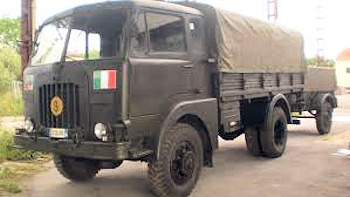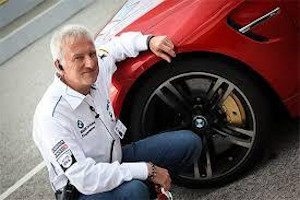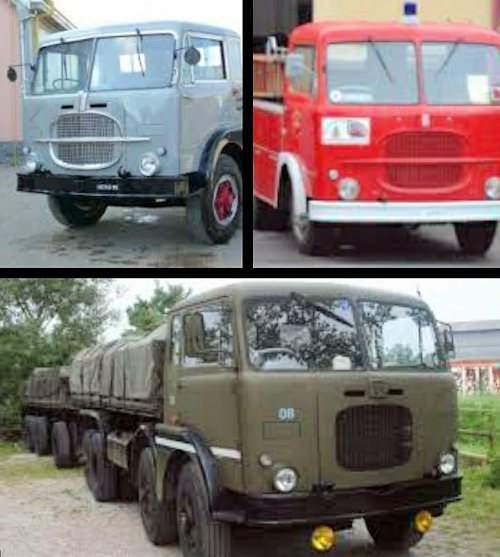The "shameless" nickname was assigned to all the civilian series on the front calender, which featured a glossy chrome-plated aluminum line transmitted to the engine's air intake, but many remind him of the military version as the school vehicle, considering all the complex maneuvers necessary to make it move. If for some the memory will be tied only to the long journeys in the body or head-machine, in the memory of most this vehicle is present mainly deployed and well aligned under the roofs of a self-parcel with olive oil paint polished with diesel, in the version in which the chrome line could not be seen.
You will have already understood that we are talking about 'OM Fiat CM 52 (Camion Medio), the 639 N3 in a civilian version, worthy of the ancestor of ACN 80. Those who have had the task of flipping the conductor as a cape machine will remember in particular the steerfasts. An operation that took place required a slight movement of the truck and a notable brute force in the arms so much that the unofficial task of the graduate in the cabin was also to help the driver steer. In fact, in its extreme robustness and relative simplicity it was not equipped with power steering and the steering wheels were about 6 from one direction to the other.
 At the base of his guide there was a fundamental rule, or "to prevent and anticipate" everything that could be present along the way, a quality that has been lagging behind with technological development but which kept the threshold of attention high even if it increased the hardship of driving. But before embarking on the new cut I would like to bring to the articles, let's briefly see the history of the OM 600 range.
At the base of his guide there was a fundamental rule, or "to prevent and anticipate" everything that could be present along the way, a quality that has been lagging behind with technological development but which kept the threshold of attention high even if it increased the hardship of driving. But before embarking on the new cut I would like to bring to the articles, let's briefly see the history of the OM 600 range.
As has already been written, the concept of makeover in the last century it was more geared toward changes in functionality and robustness than in a philosophy of pure automotive brand. In fact, from the 1930 the 600 Fiat OM remained aesthetically recognizable until the end of its production in the early 70. It should be underlined that in those years these vehicles had great success both in the military and in civilian transport. They were defined as lorries with advanced cabs (so no musoni) and the acronym N it meant Naphtha is that NMRE, Military Oil Regiment Army. On the basis of these trucks the "corriere" bodywork versions with initials were created R, lowered for use as buses.
The Milan OM mechanical workshops from 1933 entered the Fiat group, giving rise, almost for military reasons, to virtually identical civil and military vehicles (they were defined unified) and can be used in case of forced requisition by the Armed Forces; the truck versions were subdivided into read, medium e heavy and among the heavy was the predecessor of the OM 639, the Fiat 666 (who knows why he was associated with the devil's numbers) that had doors openable to the rear and was equipped with a Fiat diesel engine from 9300 cm³ and 105 CV, 4 more gearbox and front-wheel drive (photo). He contributed to the noble history of Italian transport in the first half of the last century. At Cecchignola I remember having seen several disassembled with still the plates of the Royal Army and the Crown on StanAg.
Features of CM 52
In the first version of '52 it was fitted with a 6-cylinder 6032 cm³ and 72 HP naturally aspirated Fiat engine, a 4X2 with front-wheel drive only when stationary and with the differential lock only at the rear, where it rested on twin tires. The guide was on the right side for the "Directed" arrangement of safety and visibility of the roadside, which in those periods were not as wide today. About 6 meters for just under 4 tons of empty mass, it was only slightly over the 60 Km / h. On the military version, the trapdoor was above the head of the head machine (left), while the instrumentation was complete but essential with power to 24 volt.
With all-wheel drive fitted on a very slippery surface, the twin rear doors could not get much grip and all the work, if not loaded, was carried out by the front axle with clearly single wheels, sinking until they found friction. I let you imagine the resistance of the steering wheel in these situations, even if you face it in a straight line.
The gearbox and the gearbox they were the nightmare of the soldiers who had to learn the shotgun to take the driving test. In reality, for the fans, they were fun and today probably a pleasant memory, even if similar technologies and performances would be impractical in today's chaotic traffic.

On CM 52 there were 8 gears of which normal 4 and 4 reduced. He departed with the second reduced, leaving the first short for towage or important climbs, not to overheat the clutch. Then the gear shifted in neutral and with the gear lever shifted to the fast range by re-engaging the second to take advantage of the range of revs that its propulsion could offer. With the same technique it came to the fourth and, with the same moves, climbed back to the second low. But it's not over here! In fact, on the dashboard, beside the hand throttle lever was that of the engine brake, which had to be used before the pedal brake actuated, acting only on drums that would overheat if they were not used moderately.
Back and forth in the squares of the barracks to make the movements of the students automatic and with the marshal perhaps seated on a special seat placed behind the engine compartment on the driving school versions; the cabin was divided by the engine compartment, pleasant in winter but a bit 'less summer. The exam required a tour outside the battalion and, as can be understood, there were not many who returned with a smile and license. But doing so (to the military precisely) they learned to drive and the subsequent uses on the "modern" ACM 80 or other vehicles were physiologically simpler.
His 90 liters of fuel were collected in the tank near two tanks and allowed him about 400 km of autonomy, on the left side there were the two 12 volt batteries connected in parallel and the battery-cutter.
From the 1 formula to teaching the limits
At the beginning of the article, I spoke of "preventing and anticipating" two aspects that deserve special attention and which are the basis of the professional guide and the so-called "fast" used for emergency and rescue vehicles.
 Thanks to the friend's availability Siegfried Stohr, former pilot of F1 and number one of the official driving school BMW Italy of Misano Adriatico and head instructor heavy vehicles Giorgio Porsello, and of several driving schools safe, I will be able to provide you with interesting information and advice that I hope will be useful and welcome in the field of driving safety.
Thanks to the friend's availability Siegfried Stohr, former pilot of F1 and number one of the official driving school BMW Italy of Misano Adriatico and head instructor heavy vehicles Giorgio Porsello, and of several driving schools safe, I will be able to provide you with interesting information and advice that I hope will be useful and welcome in the field of driving safety.
But to clarify the concept of prevention and forecasting in the road, I would first of all like to use a simple example. The "space time" relationship combined with natural loss when driving a vehicle for the first time is a matter that forces our brain to work more or less to store automation, movement, measurements, internal ergonomics, and so on. At this stage, which might be called familiarity with the vehicle, it follows that of experience that, alongside common sense, will make us progress from year to year.
Drivers and patents
Between the two categories there is a huge difference, never to be underestimated. In driving a vehicle - a simple car, a heavy vehicle, a wagon - it is essential to constantly keep the obstacles surrounding us, and thus also those behind us and sides, and this in order to prepare for a possible defensive reaction to prevent an accident. It is clear that the eye needs exercise to develop risk-based situations - admittedly they can predict these unknowns - and this is why professional drivers can not be defined only for passing an exam and having a driving license . But beyond this fundamental "meritocratic concept" we consider a simple example:
 Let's consider that we are on an avenue of only 500 meters that we will travel in three different ways: on foot, by bicycle and with a common 50 cc scooter. Walking on foot we could relax and observe all the shop windows, the people, the buildings and the cars. But already with a bicycle, the travel time is shortened and although the reported references remain the same as any dangerous situations, it is not certain that by cycling the same things observed on foot can be reported in detail. With the scooter at the end of the 500 meter test, we will most likely provide about half of the information. So far it all seems obvious and perhaps too simple, but in reality it is not. Just consider that with increasing speed the attention goes down towards the details defined as “insignificant” such as parked cars, people far from us, etc., while that for everything in front of us goes up. An insignificant detail such as a parked car can hide serious dangers, such as a child hidden by the shape of the car and suddenly coming out, or a door violently opened while we pass and maybe we have, without knowing it, a cyclist on the left who own at that moment it makes it impossible for us to dodge so as not to go on him. But the examples are really hundreds. A category of workers very well prepared from the point of view of automatic reflexes and prevention is represented by bus drivers in large and busy urban centers, who must also relate, in their maneuvers, to standing passengers and therefore more vulnerable.
Let's consider that we are on an avenue of only 500 meters that we will travel in three different ways: on foot, by bicycle and with a common 50 cc scooter. Walking on foot we could relax and observe all the shop windows, the people, the buildings and the cars. But already with a bicycle, the travel time is shortened and although the reported references remain the same as any dangerous situations, it is not certain that by cycling the same things observed on foot can be reported in detail. With the scooter at the end of the 500 meter test, we will most likely provide about half of the information. So far it all seems obvious and perhaps too simple, but in reality it is not. Just consider that with increasing speed the attention goes down towards the details defined as “insignificant” such as parked cars, people far from us, etc., while that for everything in front of us goes up. An insignificant detail such as a parked car can hide serious dangers, such as a child hidden by the shape of the car and suddenly coming out, or a door violently opened while we pass and maybe we have, without knowing it, a cyclist on the left who own at that moment it makes it impossible for us to dodge so as not to go on him. But the examples are really hundreds. A category of workers very well prepared from the point of view of automatic reflexes and prevention is represented by bus drivers in large and busy urban centers, who must also relate, in their maneuvers, to standing passengers and therefore more vulnerable.
Preventing these road conditions requires training and a training that in certain advanced themed courses are called defensive and preventive guidance. If you do not know each other and are not simulated in safe areas, very often you react instinctively with incorrect maneuvers and only good fortune can make us boast of being a tried motorist. "It's easy to go fast but it's hard to stop properly", this is a maxim that Siegfried's friend often emphasizes in his courses and manuals.
In the old CM 52, considering the pleasant manual effort necessary for its driving, these aspects are even more important, but today's automated systems of transmission, traction, anti-collision radar, etc., are considered elements that allow more attention on the road and not systems that can justify distractions. So driving a modern vehicle, but also of our CM 52, looking "far" and on the sides - in the mirrors - is imperative. In short, our CM was really an excellent gym for drivers who thanks to it have been able to appreciate the subsequent technological developments. The version with tank and autoscale was in service especially at the Fire Brigade and they can be witnesses of the attention to risks that is associated constantly during emergency and speed interventions. In fact, a cistern not completely full, in a curve, can drastically move the center of gravity, even at low speeds.

From the simplicity of the Fiat CM 52 to the technology of operating vehicles
Technology evolves and vehicles of today above all, in a context of active security, they allow the man more and more to rely on "electronics", obviously respecting the laws of physics and the code of the road. For example, the introduction of automatic transmissions, which today heavy vehicles, such as trucks or LMV operators, are also widely used Lynx and VTMM Bear, lightens the driving routine, allowing the driver to focus their attention on other needs, both in operating theater and on the road.
However, certain automation systems such as anti-jamming, ABS and certain mappings of automatic exchange units, especially for escort services, are modified to allow diversion and escape evolution that could be carried out without particular problems with previous construction vehicles and so less automated, while with current serial ones it would be virtually impossible. Separate economic cuts, training even with the interaction of outside professionals is crucial in the commitment of means and responsibilities.
Curiosity
Our "baffle" just does not retire, opting for an auxiliary Interim, and despite the fact that only a few units in the military field are likely to be parked, its absolute reliability still sees it as a heavy-duty tow truck or used in some civil protection association.
The engine water supply manifold was located inside the cabin adjacent to the two windshields and just above the radiator.
The T, road tractor, with 10 thousand cubic feet, had the rear cushion, while in the R version of the buses, this mechanical and design concept followed the entire production of Italian buses, up to Fiat 405 and 306, a model that moved first the engine behind.
It was sold to South America and in several locations in the world but it was Africa that crowned the King of Africa and used it unceasingly for its robustness and it is still not difficult to see it circulate.
The handbrake was placed on the left and to insert it, it was necessary to "pump" with the lever up to its block, while on the right side of the conductor was placed the lever for the passage to the front wheel drive and the activation of the differential lock.
(photo: web)












